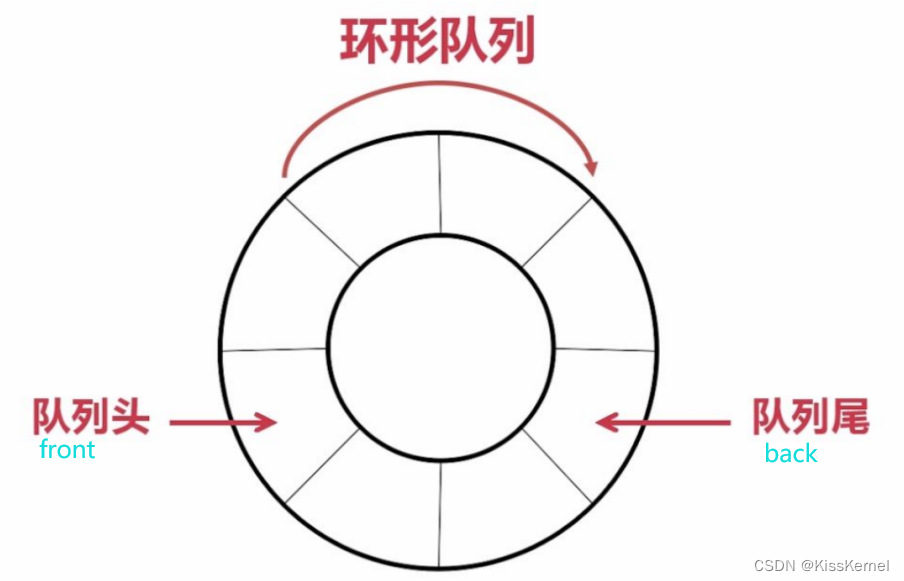栈
该博客某些图片来自 51CTO博主
栈是一种先进后出(FILO)的数据结构,栈的实现可以使用链表实现和数组实现。栈只能在一端插入和删除数据,这一端叫做栈顶,另一端就是栈底。如下图:
每次入栈的数据都会在栈顶。因此还需要一个top指针来维护栈顶的数据。
栈的模拟实现
了解了栈的结构,栈的模拟实现有两种方法:
1,使用数组模拟,因为数组在尾部的插入和删除效率很高,缺点是内存不够了需要增容。
2,使用链表模拟,将链表的头看作是栈顶,每次入栈是头插,出栈是头删,效率也很不错,相比于内存不够了就申请空间,链表是每次插入都会申请一个空间。
如果想要使用链表的尾部作为栈顶,那么就需要使用双向链表,方便在删除的时候找到前一个数据。
这两种结构都可以实现栈,但是这里使用的是数组来模拟。
因为使用数组的效率会更高一点,这里涉及到了缓存命中率和CPU预加载的问题。在《深入理解计算机系统》这本书内有详细的记载。
下面来看一下实现的代码:
//stack.h
/*
静态栈的结构体代码
#define N 100;
typedef int STDatatype;
typedef struct stack
{
STDatatype _a[N];
int _top;
int _capacity;
}ST;
*/
typedef int STDatatype;
typedef struct stack
{
STDatatype* _a;
int _top;
int _capacity;
}ST;
void StackInit(ST* ps);
void StackPush(ST* ps, STDatatype x);
void StackPop(ST* ps);
int StackSize(ST* ps);
int StackTop(ST* ps);
bool StackEmpty(ST* ps);
void StackDestory(ST* ps);
一般情况下我们实现的都是动态可变长度的栈,因为实际工程中,计算机的栈的空间一般都比较小,所以存储不了很多数据。(这里要注意,操作系统里面的栈区,和数据结构里面的栈没有任何关系,这是属于两个不同的学科里面的东西)
//stack.c
#define _CRT_SECURE_NO_WARNINGS
#include"stack.h"
void StackInit(ST* ps)
{
assert(ps);
ps->_a = NULL;
ps->_top = ps->_capacity = 0;
}
void StackPush(ST* ps, STDatatype x)
{
assert(ps);
if (ps->_top == ps->_capacity)
{
int newcap = ps->_capacity == 0 ? 4 : 2 * ps->_capacity;
STDatatype* tmp = (STDatatype*)realloc(ps->_a, sizeof(STDatatype) * newcap);
if (tmp == NULL)
{
perror("realloc fail");
exit(-1);
}
ps->_a = tmp;
ps->_capacity = newcap;
}
ps->_a[ps->_top] = x;
ps->_top++;
}
void StackPop(ST* ps)
{
assert(ps);
ps->_top--;
}
int StackSize(ST* ps)
{
assert(ps);
return ps->_top;
}
STDatatype StackTop(ST* ps)
{
assert(ps);
return ps->_a[ps->_top - 1];
}
bool StackEmpty(ST* ps)
{
assert(ps);
return ps->_top == 0;
}
void StackDestory(ST* ps)
{
assert(ps);
free(ps->_a);
ps->_top = ps->_capacity = 0;
}
stack.c这里是每个函数的具体实现
队列
队列是一种先进先出(FIFO)的结构,结构的一端是队头另一端是队尾,入数据只能在队尾,出数据在队头。

队列的模拟实现
队列只能用链表来实现,数组实现栈效率太低,例如:将数组0下标位置当作是队头,那么出队列的时候就要将后面的数据都向前移动时间复杂度是O(N),如果将0下标位置当作是队尾,那么每次插入数据都需要向后移动已经插入好的数据,所以数组不适合用来实现队列。
//queue.h
#pragma once
#include<stdio.h>
#include<assert.h>
#include<stdlib.h>
#include<stdbool.h>
typedef int QDataType;
typedef struct queue_node
{
QDataType _val;
struct queue_node* _next;
}qnode;
typedef struct queue
{
qnode* _front;
qnode* _back;
}queue;
void QueueInit(queue* pq);
void QueuePush(queue* pq, QDataType x);
void QueuePop(queue* pq);
int QueueSize(queue* pq);
QDataType QueueFront(queue* pq);
QDataType QueueBack(queue* pq);
bool QueueEmpty(queue* pq);
void QueueDestory(queue* pq);
qnode* BuyNewnode(QDataType x);
将链表的节点单独封装成一个结构体,然后队列封装成一个结构体。
#define _CRT_SECURE_NO_WARNINGS
#include"queue.h"
void QueueInit(queue* pq)
{
assert(pq);
pq->_back = NULL;
pq->_front = NULL;
}
qnode* BuyNewnode(QDataType x)
{
qnode* newnode = (qnode*)malloc(sizeof(qnode));
newnode->_val = x;
newnode->_next = NULL;
}
void QueuePush(queue* pq, QDataType x)
{
assert(pq);
qnode* newnode = BuyNewnode(x);
if (pq->_front == NULL)
{
pq->_front = pq->_back = newnode;
return;
}
pq->_back->_next = newnode;
pq->_back = newnode;
}
void QueuePop(queue* pq)
{
assert(pq);
assert(pq->_front);
qnode* cur = pq->_front;
pq->_front = pq->_front->_next;
free(cur);
if (pq->_front == NULL)
pq->_back = NULL;
}
int QueueSize(queue* pq)
{
assert(pq);
int size = 0;
qnode* cur = pq->_front;
while (cur)
{
size++;
cur = cur->_next;
}
return size;
}
QDataType QueueFront(queue* pq)
{
assert(pq);
assert(pq->_front);
return pq->_front->_val;
}
QDataType QueueBack(queue* pq)
{
assert(pq);
assert(pq->_back);
return pq->_back->_val;
}
bool QueueEmpty(queue* pq)
{
assert(pq);
return pq->_front == NULL;
}
void QueueDestory(queue* pq)
{
assert(pq);
if (pq->_front == NULL)
{
pq->_back = NULL;
return;
}
qnode* cur = pq->_front;
while (cur)
{
qnode* next = cur->_next;
free(cur);
cur = next;
}
pq->_back = NULL;
}
循环队列
循环队列是一种队列的变形,也就是将队列的首位链接起来成为一个环状的队列,循环队列的长度是一定的,一旦确定了元素个数也就确定了环的大小,这个环就不可以在改变了。
循环队列一般是使用数组实现比较简单。但是数组的长度要比元素个数大一个,也就是要空一格位置,方便判断队列满了,因为初始的时候front和back指针都是指向同一个位置,这时候队列为空,front代表的就是对头元素的位置。back就是代表队尾元素的下一个位置。因此,当(back+1)%N == front此时队列就是满了的。不可以再插入数据了。
循环队列例题
代码如下:
class MyCircularQueue {
public:
int front;
int rear;
int n;
int* val;
MyCircularQueue(int k) {
val = new int[k+1];
front = rear = 0;
n = k+1;
}
bool enQueue(int value) {
if((rear+1)%n == front)
return false;
val[rear] = value;
rear++;
rear %= n;
return true;
}
bool deQueue() {
if(front == rear)
return false;
front++;
front %= n;
return true;
}
int Front() {
if(front == rear)
return -1;
return val[front];
}
int Rear() {
if(front == rear)
return -1;
return val[(rear - 1 + n) % n];
}
bool isEmpty() {
if(front == rear)
return true;
return false;
}
bool isFull() {
if((rear+1)%n == front)
return true;
return false;
}
};
这里使用的是C++语法,new就是相当于malloc动态开辟内存并且初始化。


























 898
898











 被折叠的 条评论
为什么被折叠?
被折叠的 条评论
为什么被折叠?










